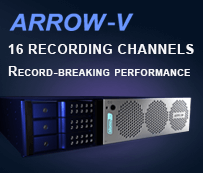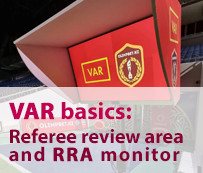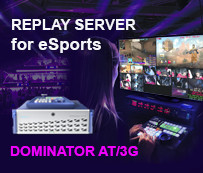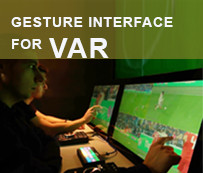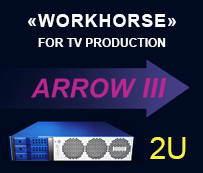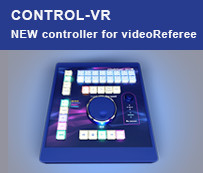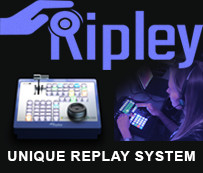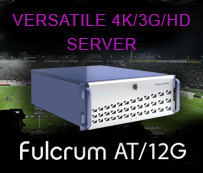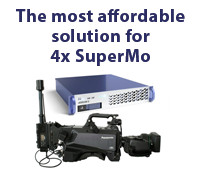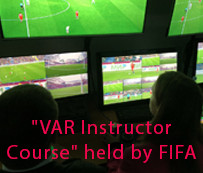- Details
TORRANCE, CA (August 10th, 2017) – On its booth (8.B40) at IBC 2017, slomo.tv, a leading international supplier of cost-effective, high performance server-based video recording and replay systems, will introduce the ninth generation of its videoReferee® system. Designated videoReferee® VG, the system supports up to 24 discrete 3G SDI video channels and supports 3G/HD/720p signals in any combination.
The system records upto 24 camera channels. The referees can analyze in-play incidents frame by frame simultaneously from several cameras and if necessary, the video image can be magnified (zoomed in). The slow motion playback is of sufficient quality that besides being used by the judges, it can be included in television broadcasts, explaining the referee’s decisions during a game.
In addition, videoReferee® VG provides an extra multi-viewer output for the referee's assistant. It supports the vR-Keypad, which enables the assistant to easily mark and label in-play incidents for subsequent or immediate search. The new system supports timing of 1/10 second increments from scoreboard computer. To achieve this level of precision slomo.tv has worked closely with more than 20 scoreboard controller manufacturers.
To comply with the latest Continental Hockey League requirements regarding archiving of recorded material, slomo.tv has developed batch export functionality in H.264 and XDCAM formats, so that the operator can start exporting with the push of just one button.
Ultra fast, intelligent operation
With slomo.tv’s videoReferee® systems, events can be marked live or on recorded video and the footage is instantly available for review. When an event is created, the system remembers the active channel, and when returning to this event starts with the same view. Also, broadcasters using slomo.tv replay servers can use marked events to create video highlight packages with controversial moments from the game.
- Details
IBC 2017 Preview
Stand number: 8.B40
15-19 September 2017
RAI, Amsterdam
Enhanced products and new strategic alliances signpost a new stage in company's evolution – best IBC ever predicted by CEO
TORRANCE, CA (July 20th, 2017) – On its booth (8.B40) at IBC 2017, slomo.tv, a leading international supplier of cost-effective, high performance server-based video record and replay systems, will showcase a range of enhanced and extended server-based products designed to meet the specific requirements of sports, and especially live TV production. All the products on display are currently being used by broadcasters throughout Europe and Asia.
At IBC 2017, slomo.tv will provide the first European showcase of videoReferee®-V - the latest addition to the company's sports video judging family which is designed to meet video refereeing applications in Soccer, Handball, Basketball, Ice Hockey and Athletics (Track and Field). With 24 channels, this 4U server supports both 3G and HD formats and has four graphics outputs for monitors of up to 4K resolution displaying GUI, Multiviewer and Referee's interfaces. It is designed to provide immediate file transfer into the sports arena network for easy decision making during in-play incidents. Also, its broadcast quality output meets all broadcasters' arena TV needs.
First introduced at IBC last year, slomo.tv’s Simple RII compact production server has already attracted attention from sport broadcasters worldwide thanks to its advanced functionality and affordable price. At IBC 2017, the company debuts an enhanced version, complete with extended 3G SDI support, six recording channels, search capabilities on all six channels and two playback channels with transition effects. In addition, slomo.tv will offer a new 8-channel 3G video refereeing option.
A key focus of the slomo.tv booth will be its Dominator AT/3G server, which was launched at NAB and now features an enhanced AVC Intra encoder option which makes it compatible with Panasonic AVC Intra and Sony XAVC media formats.
Another key development is the integrated solution for remote broadcast based on slomo.tv's Dominator AT/3G server and Production MAM by industry newcomer, HTS (booth 8.A82). This powerful combination enables users to remotely create Summaries and special Playlists as well as event logging and pre-editing during the live recording of shows.
"At IBC, we will demonstrate how slomo.tv is entering a new phase of development - capitalizing on our technological success, we are expanding into new markets," commented Mike Gilman, CEO of slomo.tv. "Kate Krivitskaya has taken on the challenging role of General Manager, which will leave me more time to work with partners and investors around the globe. We are expecting the best IBC in our history."
- Details
First major order for revolutionary new video referee system comes ahead of its IBC worldwide debut!
TORRANCE, CA (August xx, 2017) – Slomo.tv, a leading international supplier of cost-effective, high performance server-based video recording instant replay systems, has announced that professional hockey team Ak Bars from Russian Federation has tested, approved and purchased the company's new videoReferee®-4G system. The news is remarkable since the new videoReferee® won’t be officially launched until IBC 2017 next month.
Video refereeing has become a vital element of modern Ice Hockey. Europe's Continental Hockey League (KHL) now dictates that video referee systems are required in addition to investigating goal line incidents also control the blue line offside situations. This requirement means that the system must be able to record and replay an additional four channels, so judges can clearly monitor all in play incidents. Following this new requirement, the Ak Bars team, based in Kazan, Tatarstan, has purchased four additional slomo.tv vR-Cam cameras and upgraded its existing system that it acquired in 2014 to the newest version - videoReferee®-4G.
Already, slomo.tv's previous 12-channel 3G SDI system effectively doubled the recorded detail when compared with other systems and eliminated "washed" video. This superior detail allows all in-play incidents to be quickly and easily reviewed with a much better picture resolution. The system was capable of recording up to 10 channels in any combination and analyzing simultaneously up to four channels. Also, it also produces video archive recording in H.264 format.
Now, the new slomo.tv videoReferee®-4G system, which will be launched worldwide at IBC2017, supports up to 16 discrete 3G SDI video channels, as well as providing the capability to work with 3G/HD/720p signals in any combination. This space saving capability is key when the system is installed within an OB vehicle environment.
- Details
TORRANCE, CA (June 15, 2017) – "Cybersport is winning eyeballs across the globe. Analysts estimate that it will gain parity in viewing audiences with regular sporting events by the end of 2018. And no wonder, besides the magnetic attraction of gaming, an average person without outstanding physical abilities can easily become a top cybersport performer," said Yegor Voronin, General Manager of Moscow-based production company, LiveSignal.Ru. Voronin was speaking after the announcement that his production company has selected Slomo.tv to provide its BlackJack AT/3G replay servers for this summer's Warface Championship, one of Europe's leading cybersport events.
Any major sports broadcast needs action replays and cybersport is no exception. However, cybersport broadcasting places special demands on the event producers. Whereas most conventional TV broadcasts utilize interlace scan systems, cybersport works exclusively with progressive scan and requires 3G SDI signals. As a result, broadcasters must use 3G SDI systems or employ additional HDMI or DVI converters to 3G SDI.
LiveSignal.Ru, the broadcaster of the Warface Championships in Moscow, has selected Slomo.tv's BlackJack AT/3G servers to provide all replays during its programs. "Slomo.tv was the obvious choice for cybersport replays: powerful, easy to operate and compact, it fulfils all our needs and allows us to make significant savings in equipment and staff costs," explains Yegor Voronin.
Besides its ability to support progressive scan images, another key factor in LiveSignal's selection of BlackJack AT/3G is the relatively large number of 3G SDI replay channels that it offers. Blackjack provides 12 replay channels compared with other systems which offer just four 3G SDI replay channels. This capability translates to a need for just one replay operator instead of two or three, which is commonplace with other systems.
- Details
Slomo.tv, a supplier of server-based video recording and replay systems, has provided its new Dominator AT/3G production servers to the Kazakhstan state broadcaster. The servers provide content record, storage and replay facilities to the televising of the Astana-based international exhibition, EXPO 2017, which is currently underway.
With 115 participant countries and over two million visitors predicted to attend, the EXPO 2017 takes on great political as well as cultural significance in the central Asian region. Televising the EXPO 2017 opening ceremony posed significant challenges for host Broadcaster – Kazakhstan Public TV & Radio Corporation, and its flagship TV channel, 'Kazakhstan'. The first was one of scale: the opening ceremony involved several hundred actors and special effects, and included Kazakhstan President Nazarbaev welcoming exhibitors and participants to the event.
Another significant challenge presented itself in terms of restricted opportunities for rehearsal of the opening ceremony. There were very few occasions for the artistic teams and TV production teams to rehearse together. The cost and logistical challenges prevented several re-takes, but with Slomo.tv's Dominator AT/3G servers the broadcaster's team could "turn the clock back" and review the live material to select the best camera positions, focus, shot sequences and many other parameters. The broadcaster used a Dominator feature called 'The Academy'. This software-based option enables the Dominator system operator to synchronously replay and mark all recorded channels in order to choose the best shots to be included within the live broadcast stream.
During the rehearsal, two Dominator servers took live feeds from 16 HD production cameras. Immediately after capturing content the production director and producer could replay and mark up all the streams to create the best combination of shots. Also, this facility provided the broadcaster with a backup copy of all of the opening ceremony for contingency purposes.



